Bergaya F. Handbook of Clay Science
Подождите немного. Документ загружается.

cyanobacteria (Phormidium sp.) (Figs. 9.4B, C). Microbial chlorophyll was indicated
by the intense red auto-fluorescence.
The weak red pseudo-fluorescence may be ascribed to the presence of clay min-
erals. The green microbial mats, stained with Indian ink, indicated the existence of
Phormidium sp. coated with extra-cellular polymers (Fig. 9.5A). After staining the
cells with ruthenium red, the acidic polysaccharide polymers took on a pink colour
(Fig. 9.5B).
SEM and TEM images also revealed the presence of adhesive materials and that
of fine-grained particles, composed of Al, Si, and K. This would suggest the trans-
formation of K
+
-feldspar fragments to form halloysite in the layer of extra cellular
polymers on the cell surface of Phormidium sp. (Figs. 9.6A, B). The primitive clay
precursors and ha lloysite formed contained Si and Al and trace amounts of K. The
fragments of K
+
-feldspar apparently derived from the surface of coarse-grained
particles.
9.3.2. Bio-Halloysite Balls from Dam Sediments
Biomineralization was investigated in a solution containing natural dam sedime nts
collected from Portalegre, Brazil (Asada and Tazaki, 2000; Tazaki and Asada, 2003).
The microorganisms wer e cultured for a few months and up to 2 years at pH 6.0–7.4
in order to understand how microorganisms, living in microbial mats at room tem-
perature, induce the formation of clay minerals. Fig. 9.7A shows a diagram of the
cultivation system, and the formation of micr obial films on a glass slide, container
wall, and top surfa ce of the sediments. Optical microscopy of cultured microbes,
stained with DAPI, revealed the presence of spherical clays (Figs. 9.7B, C arrows).
Examination of the films by TEM clearly showed the close association of spher-
ical halloysite particles with coccus- and bacillus-type bacteria (Fig. 9.8A). The
electron diffraction pattern of the halloysite balls corresponded to reflections at
0.443, 0.256, 0.249, 0.222, and 0.148 nm (Fig. 9.8B). The films were composed of Al,
Si, S, and Fe with traces of Mg, P, K, Ca, Ti, and Mn (Fig. 9.8C). XRD gave a
d(001) spacing of 0.713 nm ascribed to (dehydrated) halloysite (Fig. 9.8D). Atomic
force microscopy (AFM) using contact mode showed formation of bio-halloysite on
the surface of bacterial cell walls. The halloysite particles formed clusters of
50–500 nm in width and 2–20 nm in thickness with an orientation along the same
direction. The clusters developed into spherical halloysite through hollow halloysite
ranging in diameter from 800 to 1000 nm (Tazaki and Asada, 2003).
9.3.3. Bio-Kaolinite and Bio-Imogolite from Weathered Feldspar
Bioweathering experiments were carried out by incubating granite in freshwater
from the Omma For mation of sandsto ne, Ishikawa Prefecture, Japan. A thin section
of granite with iron bacteria (Toxothrix sp. and Gallionella sp.) were observed. After
3–10 days microbial mats were formed on the surface of the granite. Cavities and
Chapter 9: Clays, Microorganisms, and Biomineralization486
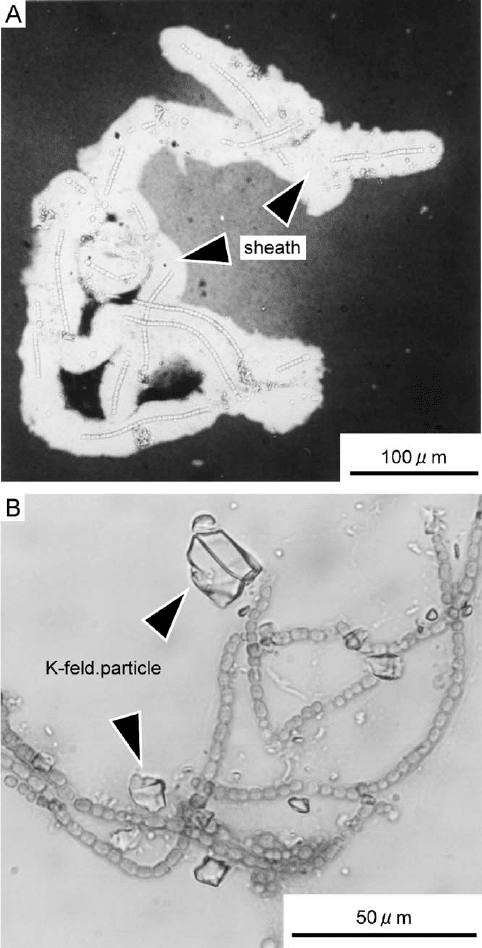
Fig. 9.5. Optical micrograph of Phormidium sp. in green microbial colony stained with Indian
ink (A) and stained with ruthenium red (B), indicating the presence of sheath (arrows in A)
and acidic polysaccharids on the cell walls together with K
+
-feldspar particles (arrows in B).
9.3. Bioformation of Halloysite, Kaolinite and Imogolite 487
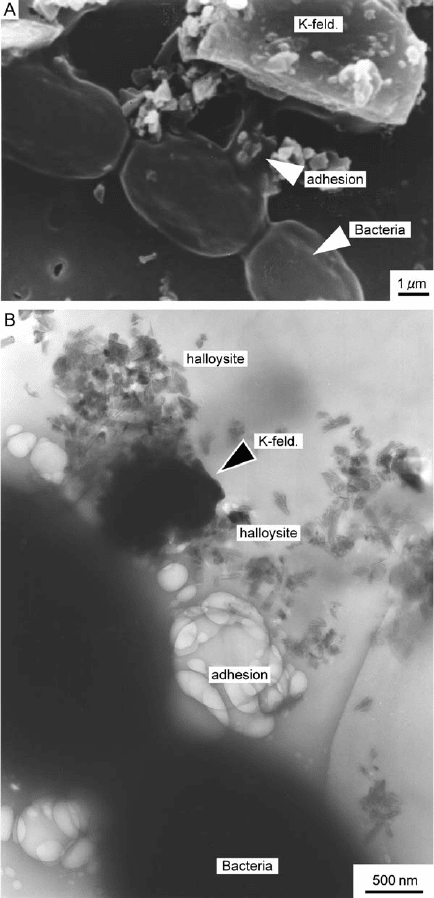
Fig. 9.6. SEM image of green colony showing the adhesive materials beside the bacteria (A)
and TEM image of Phormidium sp. adhering to K
+
-feldspar particles, forming halloysite
beside the bacteria (B).
Chapter 9: Clays, Microorganisms, and Biomineralization488
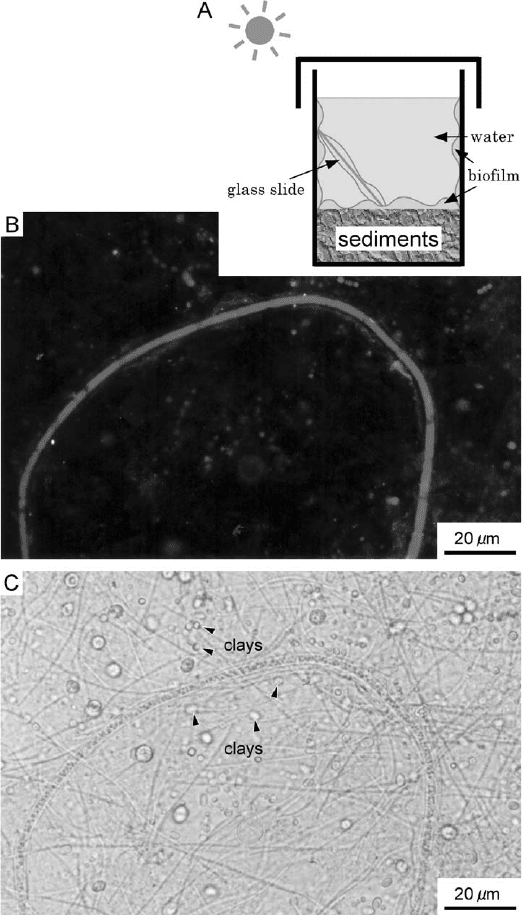
Fig. 9.7. Diagram of a natural cultivation system showing biofilm formation on a glass slide,
wall of beaker, and upper surface of sediments (A); optical micrographs of DAPI-stained
microorganisms associated with spherical clays (B, C arrows). (From Asada and Tazaki,
2000.)
9.3. Bioformation of Halloysite, Kaolinite and Imogolite 489
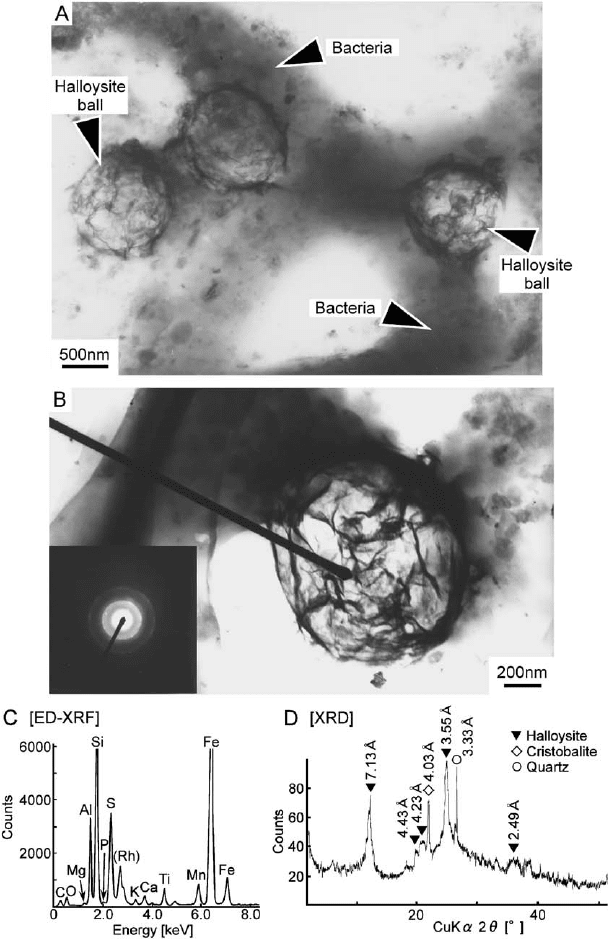
Fig. 9.8. TEM micrographs of bio-halloysite balls associated with bacillus type bacteria (A)
with electron diffraction spots and rings (B inset). ED-XRF (C) and XRD (D) analyses of a
cultured biofilm indicating presence of Al, Si, Fe, and formation of halloysite (0.713 nm).
(From Tazaki and Asada, 2003.)
Chapter 9: Clays, Microorganisms, and Biomineralization490
cracks filled with rod-like and filamentous bacteria were observed on the surface of
feldspar particles in the granite. The Si content of flake materials (Si/Al ratio of the
flakes equals 3/2), associated with bacilli on the surface of K
+
-feldspar immersed in
freshwater, was less than the value obtained with fresh K
+
-feldspar. After 2 months
of incubation, K
+
and Si
4+
ions were released from K
+
-feldspar. TEM observation
and electron diffraction analyses indicated the formation of kaolinite on the surface
of K
+
-feldspar (Ueshima and Tazaki, 1998 ).
The bioweathering of feldspar was also investigated by incubating granite with
either water from the Kurobe River, Toyama Prefecture, Japan, or deionized water.
The starting material was feldspar collected from the bank of the Kurobe river. The
composition of the latter sample is given in Figs. 9.9A–F. The river and deionized
waters have the following characteristics: pH ¼ 7.3 (5.5); Eh ¼ 313 (322) mV;
EC ¼ 84 (0.7) mS/cm; temperature ¼ 20 (21) 1C at the initial stage of the experiment.
The numbers in brackets refer to deionized water. The river water contained Na 14.7,
Mg 14.4, Al 1.6, Si 31.3, K 1.4, and Ca 36.8, all values being expressed as wt%
(Morikawa, 2002). After 55 days of incubation (in both river and deionized water) a
thin, adhesive film formed on the surface of feldspar together with a large number of
microorganisms. The film is composed of Al and Si with trace concen trations of Na,
P, S, K, and Ca (Figs. 9.9E, F). TEM of the adhesive film further showed a network
of very slender threads, indicative of imogol ite (Figs. 9.9C, F).
9.4. BIOFORMATION OF SMECTITES MINERALS
9.4.1. Bio-Nontronite from Iheya Deep-Sea Sed iments
The Okinawa Trough lies northwest of Iheya-Jima Island, Okinawa Prefecture,
Japan. It is one of the rear arc basins along the western part of the Eurasian plate,
associated with the subduction of the Philippine Sea plate along the Ryukyu Trench.
Hydrothermal smoking vents were observed at the Natsushima Sea mound in the
Iheya basin of the middle Okinawa Trough. Black manganese oxide covers the
mound and yellowish sediments are distributed along its ridge. These sediments are
composed of iron (hydr)oxide, amorphous silica, and nontronite (Tawara et al.,
1997).
The temperature of the discharge water is 2–3 1C higher than that of the ambient
sea water. The pH of the discharged water was 5, the Eh 110 mV, and the EC
47 mS/cm. A 40-cm long thermometer, inserted into the mound, recorded temper-
atures ranging from 20 to 50 1C. Analysis of the water showed a methane concen-
tration of about 200 mL/kg. Tubular and granular nontronite was identified by
XRD, SEM-EDX, and TEM. The sediments were rich in Si and Fe. Tubular ma-
terials, collected from the vicinity of deep-sea smoking vents were uniformly coated
with a film of nontronite (Fig. 9.10). After 3 minutes of ultrasonic treatment colonies
of bacilli were observed. TEM of ultra thin sections showed thin flakes of nontronite
9.4. Bioformation of Smectites Minerals 491

covered with living bacter ia (Fig. 9.11). The nontronite particles were oriented in the
same direction as the lipopolysaccharides exuded from surface of the bacterial cell
wall. This would suggest that the extracellular lipopolysaccharides could accumulate
Si and Fe from the ambient seawater, inducing nontronite crystallization on and
along the polymer chain (Ueshima and Tazaki, 2001).
Fig. 9.9. SEM micrograph of bio-weathering of feldspar grain with etch pits at initial stage
(A); weathered surface with biofilms associated with abundant bacteria (B, arrows); formation
of imogolite network structure on the surface (C); and EDX analyses of initial stage (D) and
imogolite network (E, F), showing an Al:Si ratio of about 1:1. (From Morikawa, 2002 un-
published.)
Chapter 9: Clays, Microorganisms, and Biomineralization492
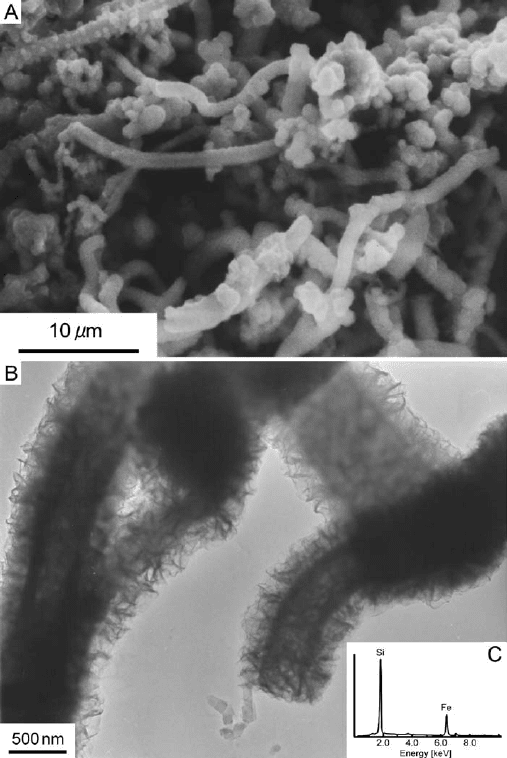
9.4.2. Bio-Smectite from a Pond of Kasaoka Bentonite Mine
Bentonite is a clay that is largely made up of the clay mineral montmorillonite
(smectite). Interaction between bentonite and microorganisms was observed in a floc
collected from the pond of the Kasaoka bentonite mine, Okayama, Japan. The floc
contained bentonite, algae, diatoms, and bacteria. The pond water had the following
Fig. 9.10. SEM-EDX (A, C) and TEM (B) micrographs of filamentous bacteria collected
from Iheya deep sea floor. The sediments are composed of Si and Fe; XRD pattern shows shift
of 1.34 nm peak to 1.72 nm after treatment with ethylene glycol, indicative of nontronite.
(From Ueshima and Tazaki, 2001.)
9.4. Bioformation of Smectites Minerals 493
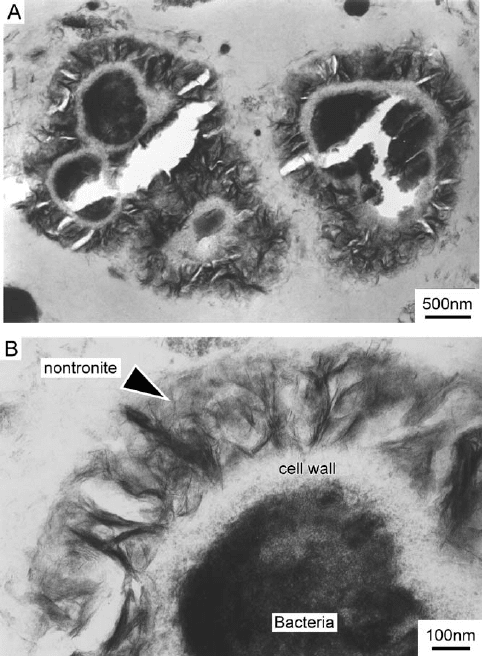
characteristics: pH ¼ 7.7, EC ¼ 120 mS/cm, DO ¼ 12 mg/L, temperature ¼ 27 1C.
The XRD pattern of the floc showed a strong peak at 1.53 nm.After treatment with
ethylene glycol this peak was shifted to 1.72 nm, characteristic of smectite (Ueshima
et al., 2000). Epifluorescence microscopy of a thin section of floc, stained with DAPI,
showed the presence of bentonite (yellow), DNA (blue), and chlorophyll of living
algae (red). SEM-EDX of the floc, following 30 min of ultrasonic treatment, showed
the presence in the algae of Al and Si together with P, S, Cl, K, and Fe (Figs. 9.12A,
B). The TEM image and the electron diffraction pattern of the algae (after ultra-
sonication) were also consistent with smectite (Fig. 9.12C and inset).
Fig. 9.11. TEM micrographs of ultra-thin section of nontronite collected from Iheya deep-sea
floor sediment, showing filamentous bacteria (in cross section) surrounded by extra-cellular
acidic polysaccharides, and covered with radially oriented nontronite particles (B arrow).
Chapter 9: Clays, Microorganisms, and Biomineralization494
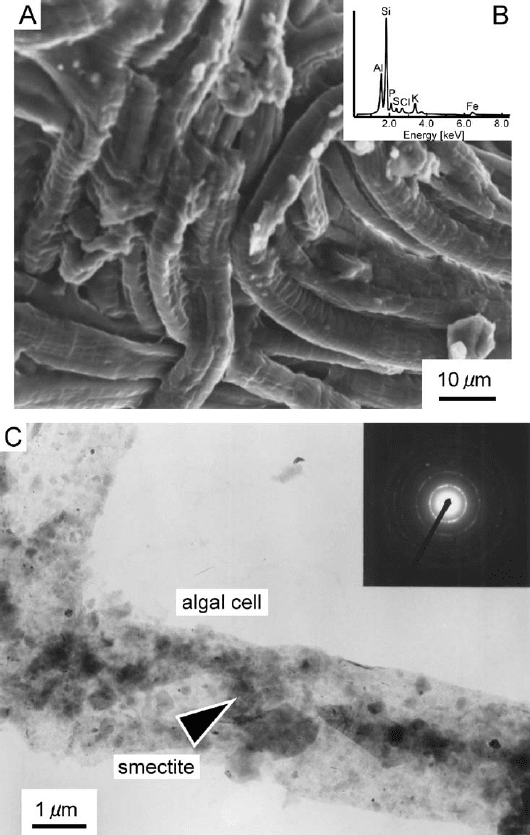
Fig. 9.12. SEM-EDX (A, B) and TEM (C) micrographs of a floc collected from the pond of
Kasaoka bentonite mine, Okayama, Japan, showing bio-bentonite (after 30 minutes of ultra-
sonic treatment). The electron diffraction pattern of an algal cell in the floc corresponds to that
of smectite (C, inset). (From Ueshima et al., 2000.)
9.4. Bioformation of Smectites Minerals 495
